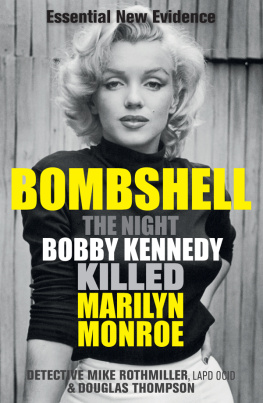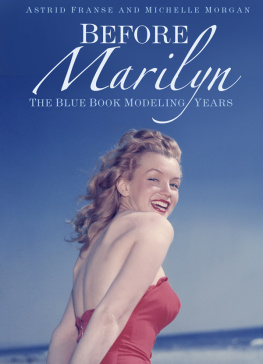
Also by Michelle Vogel and from McFarland
Lupe Vlez: The Life and Career of Hollywoods Mexican Spitfire (2012)
Marjorie Main: The Life and Films of Hollywoods Ma Kettle (2011 [2006])
Gene Tierney: A Biography (2011 [2005])
Olive Borden: The Life and Films of Hollywoods Joy Girl (2010)
Olive Thomas: The Life and Death of a Silent Film Beauty (2007)
Children of Hollywood: Accounts of Growing Up as the Sons and Daughters of Stars (2005)
Marilyn Monroe
Her Films, Her Life
Michelle Vogel
Foreword by George Chakiris

McFarland & Company, Inc., Publishers
Jefferson, North Carolina
LIBRARY OF CONGRESS CATALOGUING DATA ARE AVAILABLE
BRITISH LIBRARY CATALOGUING DATA ARE AVAILABLE
e-ISBN: 978-1-4766-1359-8
2014 Michelle Vogel. All rights reserved
No part of this book may be reproduced or transmitted in any form or by any means, electronic or mechanical, including photocopying or recording, or by any information storage and retrieval system, without permission in writing from the publisher.
On the cover: Marilyn Monroe in the 1953 film Gentlemen Prefer Blondes (Twentieth CenturyFox Film Corporation/Photofest)
No part of this book may be reproduced or transmitted in any form or by any means, electronic or mechanical, including photocopying or recording, or by any information storage and retrieval system, without permission in writing from the publisher.
McFarland & Company, Inc., Publishers
Box 611, Jefferson, North Carolina 28640
www.mcfarlandpub.com
Acknowledgments
Many thanks to Christelle Montagner, Luke Yankee, Bill Cappello, Bill Doyle, Paul Green, G.D. Hamann, Gregg Nystrom, James Robert Parish, Kristine Krueger, Greg Schreiner, Ned Comstock, Marian Collier Neuman, Scott Fortner, Jeff Stafford, Elisa Jordan, Michelle Morgan, George Bailey, Laura Petersen Balogh, Christoper Riordan, Angela Allen, Mary Mallory, Jonathon Auxier and Lois Smith.
As always, special thanks to my inner circle: My husband, Matt, our son, Ryan, my parents, Pam and Bob, and my cousin-in-law and friend, Jill, for always supporting me and encouraging me in my writing decisions, no matter what.
And to George Chakiris for his willingness to share his Marilyn Monroe memories throughout the book, including the foreword. Im truly honored that our names share the cover.
Thank you to the following institutions: AMPAS (Margaret Herrick Library), University of Southern California (USC, Cinema-Television Library, Warner Bros. Archive) and the University of California (UCLA, Los Angeles), National Library of Australia.
Marilyns type dates as far back as I can remember. Im not saying it isnt good. But she is a prototype of all the platinum blonds, curvy bundles and frothy frippery that the screen has ever seen.
Alfred Hitchcock, Stars and Stripes, July 24, 1954
Foreword
by George Chakiris
Michelle Vogel gives wonderful insight into Marilyn Monroes personal life while connecting her life to the films she made. This book makes us feel present, engaged and involved.
I was privileged to appear as a chorus dancer in two films with Marilyn Monroe, Gentlemen Prefer Blondes and Theres No Business Like Show Business. She was a serious and dedicated artist. There was something special about the way she worked that made me reflect on the experience long after it was over. She captured my imagination.
Marilyn Monroe was so beautifully creative in her performance as Lorelei Lee in Gentlemen Prefer Blondes that people still seem unable to separate the performer from the performance. Thats the type of artist Marilyn Monroe was. She felt a strong obligation to her audience, and in turn, the audience connected strongly to her. She treasured and honored that connection. She kept her audience in mind at all times. We know now that she was more than able to please her audience, and still remain true to herself. She knew (better than anyone else) exactly who Marilyn Monroe was and exactly who Norma Jeane was too. She was aware of the person she became, the person she used to be, the artist, the expectations of her fans and her place in the grand scheme of things. She had a great instinct and a keen, intelligent view of her work and career. She was very brave. Any advice and direction had to be true to her values and work ethic. She had great integrity.
Our personal experiences often influence our work, especially in creative fields such as acting, singing, and dancing. That self-expression can be very freeing. When I see Marilyn Monroe on the screen I always care very much about her, and the characters she played. The artist on the screen is someone I respect and admire.
As time has passed, we have continued to be fascinated by her. She deserves that fascination, that admiration, that respect. She definitely earned it. She had stylein spades. To this day, I admire her talent, her musical gifts and her work as an actress and entertainer.
When much that surrounds her might weather, she remains fresh, beautiful, uplifting to watch again and again. Some fifty years after her death, Marilyn Monroe is always contemporaryalways now!
George Chakiris is a singer, dancer and actor with an international career in film, television and theater. In 1962, he won an Academy Award (Best Supporting Actor) and a Golden Globe award for his role as Bernardo, leader of the Sharks gang in West Side Story.
Preface
Marilyn Monroe was a terrible actress!
Its a statement Ive heard many times, and generally it stems from ignorance rather than any solid foundation for those harsh words. After I inquire further, the clueless naysayer usually confesses to seeing only one, maybe two Marilyn Monroe filmssometimes none at all. Discrediting her entire body of work, especially based on such limited knowledge, is ludicrous. Yet its an all too common occurrence.
This book was written around the fiftieth anniversary of Marilyn Monroes passing. While Ive endeavored to give readers a thorough study of her film career, an aspect of her life that is too often underappreciated and overlooked, it would be remiss of me to discount the mysterious and disturbing circumstances associated with her death. The following pages will deal with her tragic end. Ill then take you all the way back to the very beginningher harrowing childhood and teenage years as a young wife, successful model and popular World War II pinup and cover girl.
Hundreds of books have been published about the many facets of Monroes life, but her natural talent as an actress and all-around performer is too often dismissed as a footnote, weaved into an amalgamation of complex emotional and physical maladies, powerful men who used and abused her and, of course, her untimely end that to this day is shrouded in mystery.
Insecure, self-conscious and filled with anxieties because of her traumatic past, Monroe was damaged goods. For much of her young life, she was passed around like a stray dog, given shelter and fed for a while, then hustled along to the next home and the next. From a very early age, she learned that she was a disposable commodity. Though she knew it, she never got used to it and she never got over it. Even at the height of her fame, both professionally and personally, she often felt disposable and was often treated as such. Some things never changed.
Next page











